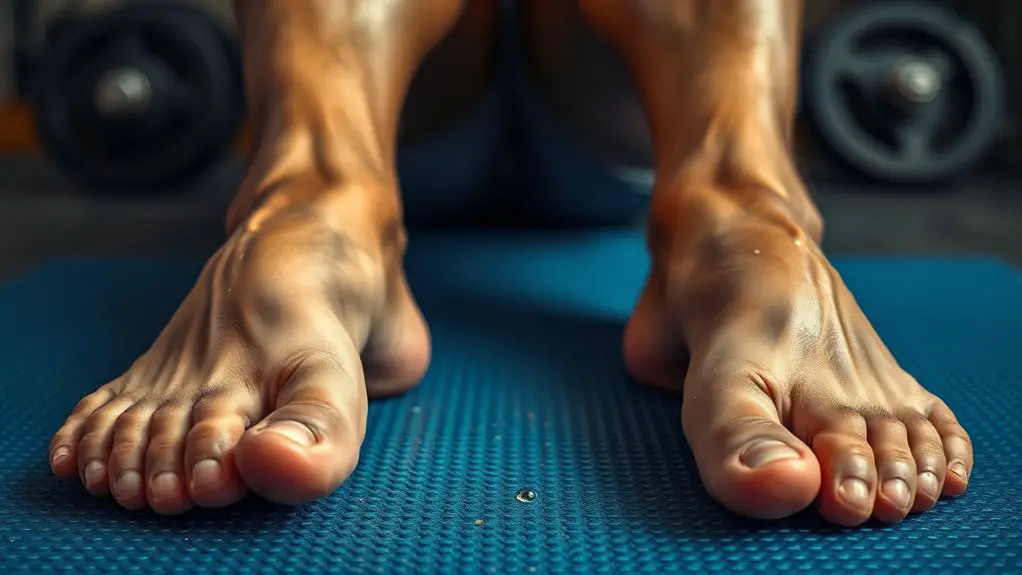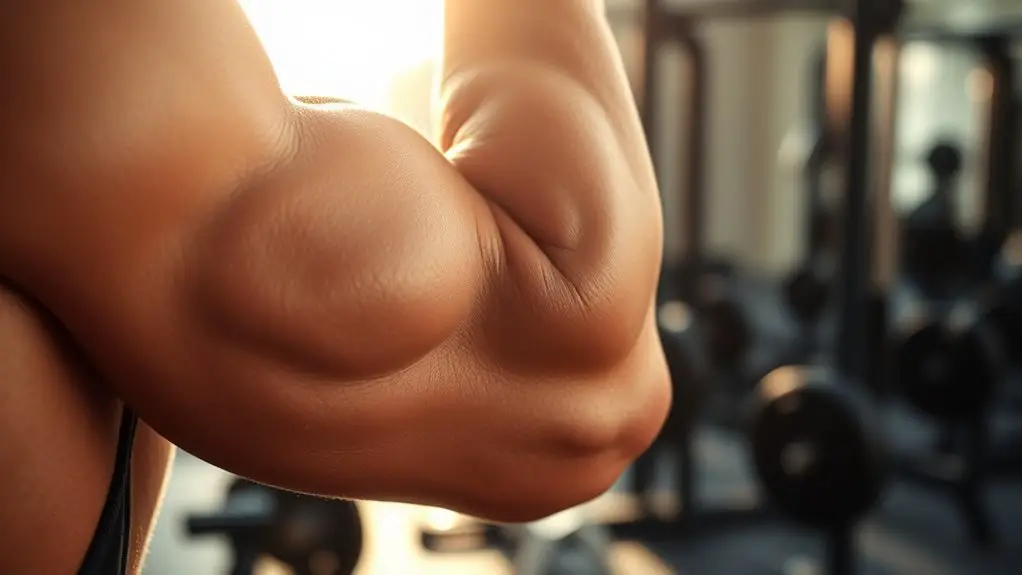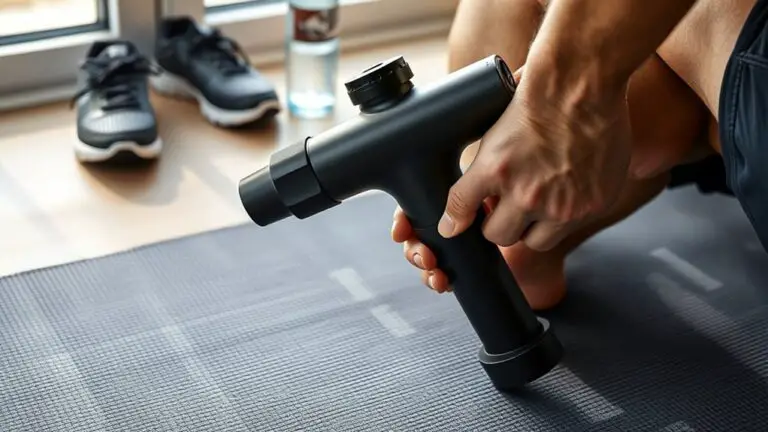The Science Behind Delayed Onset Muscle Soreness (DOMS)

Delayed Onset Muscle Soreness (DOMS) occurs 24 to 72 hours post-exercise, resulting from microscopic muscle fiber damage during intense workouts, especially eccentric movements. This damage triggers an inflammatory response, which plays a critical role in muscle repair and recovery. Factors like exercise intensity, hydration, and nutrition greatly influence DOMS severity and recovery time. Understanding these mechanisms can enhance your training strategy and promote better resilience. Learn more about effective alleviation techniques and the benefits of DOMS.
What Is Delayed Onset Muscle Soreness (DOMS)?

Delayed Onset Muscle Soreness (DOMS) refers to the muscle pain and stiffness that typically occurs after engaging in intense physical activity, especially if the activity involves eccentric movements or unfamiliar exercises. This phenomenon usually manifests 24 to 72 hours post-exercise, impacting your muscle recovery. During this period, your body undergoes various physiological changes, including inflammation and altered soreness perception, which can affect your overall performance and motivation. The underlying mechanisms of DOMS are complex, involving microtrauma to muscle fibers and subsequent adaptive processes. Research indicates that while some soreness is a normal part of muscle adaptation, excessive soreness can hinder recovery and impair subsequent training sessions. Understanding DOMS can help you manage your training intensity and recovery strategies more effectively, optimizing your performance while minimizing discomfort and the risk of injury. By addressing these factors, you can improve your exercise experience and achieve your fitness goals.
The Role of Muscle Fiber Damage
When you engage in strenuous exercise, especially involving eccentric contractions, muscle fiber damage is an inevitable outcome that plays a significant role in the development of DOMS. This damage primarily occurs at the microscopic level, where the structural integrity of muscle fibers is compromised. As you push your limits, the extent of fiber recruitment increases, leading to more pronounced damage.
In response to this injury, your body initiates muscle repair processes. Satellite cells are activated, proliferating and differentiating to aid in the regeneration of the damaged fibers. This repair process is essential, as it not only restores muscle function but also leads to adaptations that enhance strength and endurance over time.
Understanding the connection between muscle fiber damage and DOMS can help you tailor your training regimen, allowing for better recovery strategies and improved performance in future workouts. Balancing intensity and recovery is key to optimizing your results.
Inflammatory Responses and Their Impact

As your muscles undergo damage from intense exercise, inflammatory responses become a critical component of the recovery process. These responses involve a complex interplay of inflammatory mediators that trigger an immune response, facilitating healing. Understanding this process can help you manage DOMS effectively.
Here are four key aspects of inflammatory responses:
- Cytokines: These proteins are released by immune cells and contribute to muscle repair by modulating inflammation.
- Prostaglandins: These lipid compounds increase blood flow to damaged tissues, aiding nutrient delivery.
- Macrophages: Immune cells that clear out dead tissue and promote regeneration of muscle fibers.
- Inflammation Duration: While essential, prolonged inflammation can hinder recovery, emphasizing the need for balanced immune responses.
The Connection Between Exercise Intensity and DOMS
When you engage in higher intensity exercise, the type of activity greatly influences the degree of muscle fiber damage, which is a key factor in the development of DOMS. This damage not only affects the immediate sensation of soreness but also extends the recovery time required before your muscles are fully functional again. Understanding these relationships can help you tailor your training regimen to minimize discomfort while optimizing performance.
Exercise Type Influence
Although various factors contribute to Delayed Onset Muscle Soreness (DOMS), the type and intensity of exercise play a pivotal role in its development. Different exercises induce varying levels of muscle stress, leading to DOMS manifestation. Here’s how specific activities influence soreness:
- Strength Training: Particularly resistance training with eccentric movements generates more microtears in muscle fibers.
- High Intensity Workouts: These often engage large muscle groups, amplifying the risk of DOMS due to increased strain.
- Plyometric Exercises: The explosive nature of these activities can severely challenge muscle capacity, resulting in significant soreness.
- Endurance Activities: While less intense, prolonged sessions can still lead to DOMS, especially if combined with resistance elements.
Understanding these nuances can help you tailor your routine to manage DOMS effectively.
Muscle Fiber Damage
The intensity of exercise directly correlates with the extent of muscle fiber damage, a primary factor in the onset of Delayed Onset Muscle Soreness (DOMS). When you push your body beyond its soreness thresholds, microtears occur in muscle fibers, triggering an inflammatory response. This damage initiates muscle repair processes, which are crucial for recovery and strength gains. Research shows that higher intensity workouts lead to greater muscle fiber disruption, subsequently increasing the severity of DOMS. The interplay between the level of exertion and the resulting muscle repair mechanisms underscores the importance of understanding your limits. By recognizing how exercise intensity influences muscle fiber damage, you can better manage your training regimen and minimize discomfort while still achieving fitness goals.
Recovery Time Variations
While varying exercise intensities can lead to different levels of muscle fiber damage, they also greatly impact recovery time from Delayed Onset Muscle Soreness (DOMS). Your individual recovery can hinge on various factors, including:
- Genetic Factors: Genetic predispositions affect muscle repair rates.
- Hydration Impact: Adequate hydration enhances recovery and reduces soreness.
- Nutrition Role: Proper nutrition supports muscle repair and reduces recovery time.
- Sleep Importance: Quality sleep is essential for ideal recovery processes.
Other influences include age effects, training history, and stress levels. As you increase exercise intensity, understanding these variables can help tailor your recovery strategies, ultimately improving your performance and resilience against DOMS.
The Timeline of DOMS Development
Understanding the timeline of DOMS development is essential for managing your recovery effectively. Initially, muscle damage occurs immediately after intense exercise, followed by an inflammatory response that peaks around 24 to 72 hours post-exercise. This process ultimately leads to recovery and adaptation, facilitating improved performance in subsequent workouts.
Initial Muscle Damage
When engaging in unfamiliar or intense physical activity, you may experience initial muscle damage that sets the stage for Delayed Onset Muscle Soreness (DOMS). This damage occurs at the microstructural level, leading to a cascade of events that influence muscle repair and soreness perception.
- Myofibrillar Disruption: Muscle fibers sustain microtears, initiating the repair process.
- Eccentric Loading: Activities involving lengthening contractions exacerbate muscle damage.
- Cellular Response: Satellite cells are activated, contributing to muscle regeneration.
- Pain Sensitization: Neural pathways are altered, heightening your perception of soreness.
Understanding this timeline is essential; it helps clarify why DOMS occurs and emphasizes the importance of recovery for peak muscle function.
Inflammatory Response Phase
Following the initial muscle damage, the inflammatory response phase begins to unfold, playing a pivotal role in the development of Delayed Onset Muscle Soreness (DOMS). During this phase, various inflammatory markers are released, signaling the immune response to the affected tissues. You’ll notice these markers, such as cytokines and prostaglandins, help recruit immune cells to the injury site, initiating the healing process. This response typically peaks between 24 to 72 hours post-exercise, correlating with increased soreness.
| Time Post-Injury | Inflammatory Markers | Immune Response |
|---|---|---|
| 0-24 hours | Minimal | Initial response |
| 24-48 hours | Increased | Cellular recruitment |
| 48-72 hours | Peak levels | Tissue repair |
| 72+ hours | Gradual decline | Resolution phase |
Recovery and Adaptation
As your body begins to heal from the muscle damage incurred during intense exercise, the recovery and adaptation process unfolds in a series of distinct phases. Understanding these phases can optimize your recovery strategies.
- Initial Repair (1-3 days): Inflammatory processes clear damaged tissue, preparing for regeneration.
- Active Recovery (3-7 days): Engaging in low-intensity activities promotes blood flow, aiding nutrient delivery and waste removal.
- Hydration Strategies: Maintaining adequate fluid intake supports cellular functions and reduces muscle cramping.
- Muscle Adaptation (1-2 weeks): Your muscles adapt to the stress, becoming stronger and more resilient to future workouts.
Implementing these strategies can greatly enhance your recovery, ensuring you’re ready for your next training session with reduced soreness and improved performance.
Factors Influencing the Severity of DOMS
Several key factors influence the severity of Delayed Onset Muscle Soreness (DOMS), impacting your recovery and overall workout experience. One significant factor is genetic predisposition; individuals with a higher proportion of slow-twitch muscle fibers often experience less severe DOMS compared to those with more fast-twitch fibers. This genetic trait can affect muscle repair and adaptation following exercise.
Hydration levels are another vital element. Studies indicate that dehydration can exacerbate muscle cell damage and inflammation, increasing DOMS severity. Adequate hydration supports ideal muscle function and recovery, helping to mitigate soreness.
Additionally, the type and intensity of exercise play essential roles. Eccentric movements, which lengthen muscles under tension, commonly induce more soreness than concentric actions. Understanding these factors can help you tailor your training approach and recovery strategies, ultimately enhancing your performance and reducing discomfort associated with DOMS.
Strategies for Alleviating Muscle Soreness

Understanding the factors influencing DOMS can guide you in implementing effective strategies for alleviating muscle soreness. Here are four evidence-based approaches:
- Active Recovery: Engage in low-intensity exercises like walking or cycling to enhance blood flow, promoting quicker recovery.
- Hydration Strategies: Maintaining adequate hydration supports muscle function and reduces soreness, so drink water before, during, and after workouts.
- Foam Rolling and Massage Therapy: Incorporate foam rolling and massage techniques to release muscle tightness and improve circulation, aiding in soreness reduction.
- Heat Therapy and Compression Garments: Utilize heat therapy to relax muscles and apply compression garments post-exercise to minimize swelling and enhance recovery.
Additionally, focus on nutrition by consuming protein and anti-inflammatory foods to support muscle repair. Furthermore, incorporate stretching techniques to enhance flexibility and reduce tension. These strategies can effectively manage DOMS and facilitate a smoother recovery process.
Long-Term Adaptations and Benefits of DOMS
While experiencing Delayed Onset Muscle Soreness (DOMS) can be uncomfortable, it’s important to recognize its role in the body’s adaptive processes. DOMS serves as a signal that your muscles are undergoing microtrauma, which ultimately leads to muscle adaptation. This adaptation is vital for enhancing strength and endurance over time.
| Adaptation Type | Training Benefit |
|---|---|
| Muscle Hypertrophy | Increased muscle size |
| Neural Adaptations | Improved coordination |
| Tendon Strengthening | Enhanced injury resistance |
As you continue your training, the cumulative effects of DOMS can lead to improved performance. Regular exposure to this type of stress encourages muscle fibers to adapt, facilitating better recovery and greater overall efficiency in subsequent workouts. Embracing DOMS as a natural part of your training journey can enhance your long-term fitness outcomes.
Frequently Asked Questions
Can DOMS Occur Without Visible Muscle Damage?
Imagine a tree growing in a storm; it bends but doesn’t break. Similarly, you might experience soreness without visible muscle damage. This phenomenon often relates to muscle adaptation and soreness perception. Your body adapts to new stresses, leading to micro-tears that aren’t always visible. This discomfort signals your muscles are strengthening, even if they appear unscathed. So yes, DOMS can occur without visible damage as your body fine-tunes itself for future challenges.
Is DOMS the Same as Regular Muscle Soreness?
No, DOMS isn’t the same as regular muscle soreness. While both involve discomfort post-exercise, DOMS typically has a delayed onset and lasts longer, often peaking around 24 to 72 hours after activity. Regular soreness, on the other hand, usually resolves more quickly. Understanding these differences is essential for effective muscle recovery strategies, as the duration of soreness can inform your training adjustments and recovery protocols to optimize performance and minimize injury risk.
How Does Hydration Affect DOMS Severity?
When you push your muscles to their limits, they might not thank you the next day. Proper hydration strategies play an essential role in muscle recovery. Staying well-hydrated helps maintain ideal blood flow, delivering essential nutrients to sore muscles. This can potentially reduce the severity of discomfort. Research suggests that adequate hydration mitigates inflammation and promotes faster recovery, so don’t underestimate the power of water in your post-workout routine.
Does Nutrition Play a Role in DOMS Recovery?
Yes, nutrition plays an essential role in your recovery from exercise-related muscle soreness. Implementing nutrition timing—consuming carbohydrates and proteins shortly after a workout—can enhance muscle repair and reduce soreness. Evidence suggests that adequate protein intake supports muscle recovery, while carbohydrates replenish glycogen stores, promoting overall recovery strategies. By focusing on balanced meals and timely nutrient consumption, you can effectively mitigate the effects of muscle soreness and improve your overall performance.
Are Certain Exercises More Likely to Cause DOMS?
Like a storm brews before the rain, certain exercises indeed stir up muscle soreness. Eccentric exercises, which involve lengthening muscles under tension, and high-intensity workouts are particularly notorious for inducing this phenomenon. Research shows that these types of activities create micro-tears in muscle fibers, leading to an inflammatory response that results in delayed onset muscle soreness. Consequently, if you engage in these workouts, expect some soreness as a natural part of your body’s adaptation process.





